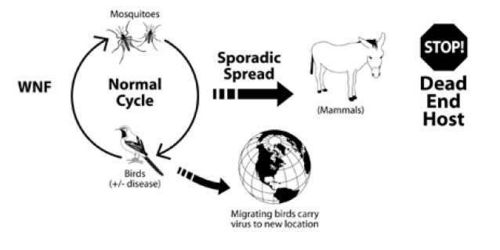Difference between revisions of "West Nile Fever (WNF) - Donkey"
| Line 7: | Line 7: | ||
==Clinical signs== | ==Clinical signs== | ||
| − | <u>Horses show a variety of clinical signs which are often non-specific.</u> In the Camargue outbreak the signs recorded for the 76 equidae included '''fever, ataxia, paresis/paralysis, tremor, hyperaesthesia, grinding of the teeth, abnormal behaviour and hepatitis'''. | + | <u>[[West Nile Virus|Horses]] show a variety of clinical signs which are often non-specific.</u> In the Camargue outbreak the signs recorded for the 76 equidae included '''fever, ataxia, paresis/paralysis, tremor, hyperaesthesia, grinding of the teeth, abnormal behaviour and hepatitis'''. |
The one '''donkey''' affected exhibited '''neurological signs''', followed by a '''short period of remission''', and then '''severe hepatic failure'''. Oudar (1971) described signs of fever, anorexia, constipation, congested ocular mucous membranes and epiphora in a three-year old jenny. A full clinical profile is yet to be established for donkeys affected by WNF. | The one '''donkey''' affected exhibited '''neurological signs''', followed by a '''short period of remission''', and then '''severe hepatic failure'''. Oudar (1971) described signs of fever, anorexia, constipation, congested ocular mucous membranes and epiphora in a three-year old jenny. A full clinical profile is yet to be established for donkeys affected by WNF. | ||
Latest revision as of 21:57, 8 June 2011
Introduction

West Nile fever is caused by one of the most widely distributed arboviridae viruses. Bird-feeding mosquitoes are the main vector and wild birds are the main host. The virus undergoes an amplification cycle between the bird and mosquito and under certain conditions can spread to other animals, including donkeys. A recent outbreak in Camargue, France (Murgue, 2001) has brought the condition closer to the UK. In this outbreak one donkey was euthanased and twenty horses either died or were euthanased.
The zoonotic potential of this disease is the overwhelming concern. However, the information available seems to indicate that the level of virus is low or undetectable in donkeys (Oudar, 1971). This suggests that donkeys, like horses, may be dead end hosts.
Clinical signs
Horses show a variety of clinical signs which are often non-specific. In the Camargue outbreak the signs recorded for the 76 equidae included fever, ataxia, paresis/paralysis, tremor, hyperaesthesia, grinding of the teeth, abnormal behaviour and hepatitis.
The one donkey affected exhibited neurological signs, followed by a short period of remission, and then severe hepatic failure. Oudar (1971) described signs of fever, anorexia, constipation, congested ocular mucous membranes and epiphora in a three-year old jenny. A full clinical profile is yet to be established for donkeys affected by WNF.
Diagnosis
- Virus isolation and identification
- Serological testing
Treatment
- Supportive and symptomatic treatment of mild cases
Control
- Vaccination and vector control
Literature Search
Use these links to find recent scientific publications via CAB Abstracts (log in required unless accessing from a subscribing organisation).
West Nile Fever in donkeys publications
References
- Anzuino, J. (2008) Exotic infections In Svendsen, E.D., Duncan, J. and Hadrill, D. (2008) The Professional Handbook of the Donkey, 4th edition, Whittet Books, Chapter 14
|
|
This section was sponsored and content provided by THE DONKEY SANCTUARY |
|---|
